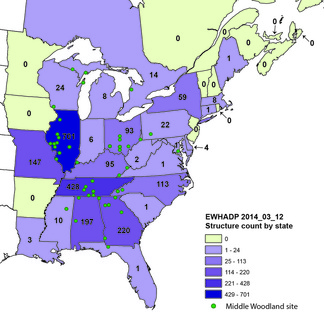I've been invited to give a short presentation on the EWHADP for the DINAA (Digital Index of North American Archaeology) workshop that will be going on at the University of Tennessee this week. DINAA is operating through Open Context, which is a web-based, open access initiative that "reviews, edits, and publishes archaeological research data." It is possible that this site and the information it contains will eventually be linked to DINAA in some way or another. There could be several advantages to such a linkage. The most obvious one, of course, would be a general increase in the ease of access to information for everyone. Open access is good. Period.
I'm not yet sure exactly what I'm going to talk about. Since the site is new, I will probably focus on my motivations for creating it and what I hope it accomplishes. I will be able to give my opinions on the downside of the regionalization of research data and agendas and the upside of blurring the lines between regions by linking smaller scale datasets into larger ones. Whatever the specific content of my DINAA presentation, it will be a relief to talk for an entire 15 minutes without attempting to describe complex systems theory. Also, since it will be via Skype, I can wear slippers and be almost certain that I won't miss my connecting flight.
I'm not yet sure exactly what I'm going to talk about. Since the site is new, I will probably focus on my motivations for creating it and what I hope it accomplishes. I will be able to give my opinions on the downside of the regionalization of research data and agendas and the upside of blurring the lines between regions by linking smaller scale datasets into larger ones. Whatever the specific content of my DINAA presentation, it will be a relief to talk for an entire 15 minutes without attempting to describe complex systems theory. Also, since it will be via Skype, I can wear slippers and be almost certain that I won't miss my connecting flight.
| I produced the map above for my presentation. It shows the current number of listings in the database by state/province. The large numbers of structures at many Mississippian settlements produce the high counts in Illinois and several states in the Southeast (figure to right). The dataset is weakest all along the Atlantic coast and on the western side of the Mississippi River. It would be interesting to know to what degree we can attribute the absence of database listings to (1) the absence of structures and/or (2) the absence of excavated structures. In other words, does the absence of structures in the database reflect a real absence of structures or, alternatively, simply the absence of information about those structures? The EWHADP will not be able to answer that question by itself. First, it is far too early in development of the database to know if a lack of reported structures from an area means that structures have not been identified there. There are a lot more data to be entered and a lot more tree shaking to be done before we can really see where there are spatial gaps. Second, because the EWHADP is only concerned with positive evidence (i.e., sites with structures present), it cannot answer questions about negative evidence (i.e., sites with no structures present). Linking to efforts like DINAA will be required to allow one to confidently discriminate between the absence of evidence and evidence of absence. Such a linking will also allow the spatial distribution of structures to be systematically examined in relation to the spatial distribution of other kinds of archaeological remains. Sounds like a winner to me. |



 RSS Feed
RSS Feed
